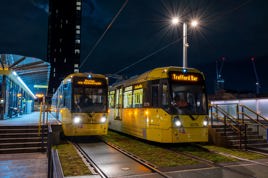It is no slight on UK Tram to say it has not had the profile of other rail industry bodies, such as Rail Delivery Group or Railway Industry Association.
This is because Britain, with typical lack of foresight, closed all but one of its urban tram systems by the early Sixties - in marked contrast to continental Europe, where many towns and cities realised the value of electrically powered urban public transport and retained them.
Britain’s last system closed in Glasgow in 1962, leaving only Blackpool before a glacial pace of reintroductions began with the Tyne and Wear Metro in 1980.
Since then, Newcastle has been joined by seven other systems. But no entirely new conventional tram system is under construction or been authorised, although several extensions are being built - such as the West Midlands Metro to Dudley, a line that has been under discussion for more than 40 years.
What may change the outlook in Britain is adoption of the tram-train, which meets both light rail and national rail standards to allow trams to use heavy rail into the suburbs and light rail into city centres.
Few people have more experience of tram-trains than new UK Tram Chairman Steve Edwards. He was Director General for South Yorkshire Passenger Transport Executive (SYPTE), which was responsible for introducing (in 2018) Britain’s first tram-train between Sheffield Cathedral, Rotherham and Parkgate Shopping as part of Sheffield Supertram.
It took the better part of a decade for Britain’s first tram-train to enter service, delayed by the cautious approach to the pilot scheme and its approval processes.
“The great benefit of tram-train is taking people into the heart of towns and cities without having to change, while reducing demand for platforms at main stations and at network bottlenecks,” says Edwards.
“The lessons learned in Sheffield have been applied to the next scheme in Cardiff and paved the way for tram-train to become a natural option in evaluating some reopening schemes such as Wisbech.”
Helping stakeholders make the case for light rail is a major part of UK Tram’s role.
“Everyone wants greater investment given the challenges of decarbonisation and moving an expanding population in a more efficient way. Our role is to help scheme promoters to come up with the most viable proposal,” Edwards explains.
“The Department for Transport business case evaluation is used to assess their viability, but most local authorities need more hand holding than they would for rail schemes.
Given how many Brits experience the benefits of tram systems during their travels abroad, Edwards is surprised there isn’t greater demand for the scope and quality to be raised at home.
A measure of how far behind Britain lags, with just nine systems, is France (which has 26 for a comparable population) and Germany (57, albeit with a larger population at 83 million).
Among the schemes under very early development in Britain are: KenEx Tram to link Dartford, Swanscombe, Gravesend, Ebbsfleet International and Grays; Folkestone; Bristol; Stoke-on-Trent; and (most promisingly) Leeds, Europe’s largest city without a light rail network and recently offered funding by the government.
Transport for Greater Manchester considers the target of half of all journeys being by active travel or public transport by 2040 as fundamental to its decarbonisation ambitions.
But Edwards is concerned that “other emissions such as particulates are getting lost with the focus on decarbonisation by moving to electric cars. Electric cars are not enough to shift the dial in terms of particulate pollution or congestion”.
He adds: “Not enough attention is being paid to the comparison between light rail costs and the huge costs attached to creating the electric charging infrastructure and the generating infrastructure. We get hung up on high initial costs of light rail without taking a long-term view of the benefits.”
















Login to comment
Comments
No comments have been made yet.